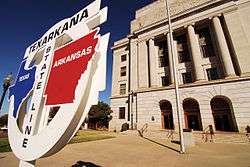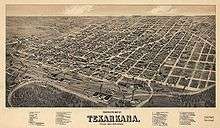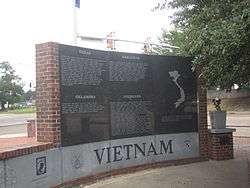Texarkana metropolitan area
The Texarkana metropolitan statistical area (MSA), as defined by the United States Office of Management and Budget, is a two-county region anchored by the twin cities of Texarkana, Texas, (population 37,333) and Texarkana, Arkansas, (population 30,259), and encompassing the surrounding communities in Bowie County, Texas, and Miller County, Arkansas. As of the 2016 census, the MSA had a population of 150,098.[4] Texarkana is a subset of the broader Ark-La-Tex region.
Texarkana, United States | |
|---|---|
City | |
 Texarkana Post Office, located in two states. | |
| Nickname(s): TK, Flexarkana | |
| Motto(s): Twice as Nice | |
| Coordinates: 33°26′14″N 94°4′3″W | |
| Country | United States |
| State | Arkansas & Texas |
| County | Miller County, AR Bowie County, TX |
| Government | |
| • AR Mayor | Allen L. Brown |
| • TX Mayor | Bob Bruggeman.[1] |
| Elevation | 299 ft (91 m) |
| Population (2016) | |
| • Total | 150,098 |
| Time zone | UTC−6 (Central (CST)) |
| • Summer (DST) | UTC−5 (CDT) |
| ZIP codes | (AR) 71854 (TX) 75500-75599 |
| Area code(s) | (AR) 870 (TX) 430 & 903 |
| FIPS code | 48-72368[2] |
| GNIS feature ID | 1369752[3] |
| Website | Texarkana MSA |
| Part of a series on |
| Regions of Arkansas |
|---|
 |
|
Geographic Regions |
|
Administrative divisions
|
History


Texarkana
Texarkana was founded in 1873 on the junction of two railroads. The name is a portmanteau of TEXas, ARKansas, and nearby LouisiANA. One tradition tells of a Red River steamboat named The Texarkana, c. 1860. Another story mentions a storekeeper named Swindle in Red Land, Louisiana who concocted a drink called "Texarkana Bitters". A third account states that Col. Gus Knobel, a railroad surveyor, coined the name.[6] Local lore suggests that, before Texas's annexation by the US, lawlessness ruled in the area that at times was claimed by various nations.
In 1876, Texarkana, Texas, was granted a charter under an act of the Texas legislature, and a Texarkana, Texas, post office operated from 1886 to 1892. Later, Congressman Morris Sheppard (D-TX) secured a postal order officially changing the name to "Texarkana, Arkansas-Texas".[6]
Texarkana metropolitan area
The Texarkana metropolitan area was first defined in 1960.[7] Then known as the Texarkana, TX–Texarkana, AR Standard Metropolitan Statistical Area, it consisted of Bowie County, Texas, and Miller County, Arkansas. In 1963, the area was renamed the Texarkana, TX–AR Standard Metropolitan Statistical Area,[8] only to return to its original name in 1971.[9]
Little River County, Arkansas, was added to the SMSA in 1973.[10] In 1983, the official name was shortened to the Texarkana, TX–Texarkana, AR Metropolitan Statistical Area, which is still in use.[11] That same year, Little River County was removed from the MSA. The two-county MSA had a population of 137,486 in 2000.
Demographics
As of the census[2] of 2000, there were 137,486 people, 72,695 households, and 55,524 families residing within the MSA. The racial makeup of the MSA was 53.5% White, 43.3% African American, 0.6% Native American, 0.4% Asian, <0.1% Pacific Islander, 0.9% from other races, and 1.2% from two or more races. Hispanic or Latino of any race were 3.6% of the population.
The median income for a household in the MSA was $31,976, and the median income for a family was $38,887. Males had a median income of $32,482 versus $21,408 for females. The per capita income for the MSA was $16,901.
Economy
Texarkana began as a railroad and lumber center, and developed in the 20th century as a regional agricultural processing, retail, wholesale, and service center.[12] Red River Army Depot and Lone Star Army Ammunition Plant were the largest regional employers from the 1940s through the 1970s. Paper mills near Ashdown and Atlanta, as well as other industrial facilities, brought new jobs to the area in the 1970s. Today the Texarkana area is a diversified economy whose pattern of employment categorized by industry is very similar to the entire state of Arkansas.[13]
| Employer | Local employees |
|---|---|
| Red River Army Depot & Tenants | 7,200 |
| Christus St. Michael Health System | 1,883 |
| Cooper Tire & Rubber | 1,700 |
| Domtar | 1,300 |
| Texarkana (TX) Independent School District | 1,100 |
| Walmart | 967 |
| International Paper | 960 |
| Texarkana (AR) School District | 835 |
| Wadley Regional Medical Center | 778 |
| Southern Refrigerated Transport | 750 |
Geography
Texarkana consists of two separate municipal designations:
- Texarkana, Arkansas, the county seat of Miller County, Arkansas
- Texarkana, Texas, located in Bowie County, Texas
State Line Avenue follows the Texas-Arkansas state line throughout much of Texarkana. The two "sides" of Texarkana are separate only from a political standpoint. Thousands of locals actually live in one state and work in the other.
Owing to its divided political nature, Texarkana has two mayors and two sets of city officials; however, the two sides share a federal building, courthouse, jail, post office, labor office, chamber of commerce, water utility, and several other offices.[6]
Transportation
Texarkana is located at the intersection of Interstate 30 and Interstate 49. It is situated approximately halfway between Dallas, Texas, and Little Rock, Arkansas.
Air service
Texarkana Regional Airport[15] is located inside the northeastern city limits and is included in the National Plan of Integrated Airport Systems for 2011–2015, which categorized it as a primary commercial service airport.
The airport covers an area of 964 acres (390 ha) at an elevation of 390 feet (119 m) above mean sea level and it has two runways with asphalt surfaces:
- Runway 4/22 is 6,601 by 144 feet (2,012 x 44 m)
- Runway 13/31 is 5,200 by 100 feet (1,585 x 30 m)
Highways
Major routes in Texarkana include:







As of October 2015, new interchanges had been completed at the junctions of I-30/US 59, and I-30/I-49. Interstate 49 had been extended south to Shreveport with its northern extension planned into Kansas City along the U.S. Route 71 corridor. Multiple projects were under construction to relieve the strain on local roadways, including continuous access roads and the expansion of area highways and bridges.
Railways
Rail service in Texarkana is provided by:
Culture and education


Notable historical buildings in Texarkana include the post office and federal building that straddle the state line, the Ace of Clubs House, The Perot Theater, and Texarkana Regional Museum. The Aces of Clubs House is shaped like a club on a playing card and supposedly inspired by a winning poker hand.
The Texarkana Symphony Orchestra was established in 2005, providing the community with several professional concerts of classical music every year. In 2007, the Texarkana Youth Symphony Orchestra was established, presenting spring and winter concerts.
Texarkana College, a community college whose origins date to 1927, enrolls more than four thousand annually.
In 1971, East Texas State University began offering classes at the campus, an institution that later became Texas A&M University–Texarkana. Texas A&M University-Texarkana has constructed a large campus at Bringle Lake. Historically an upperclassmen and graduate institution, in 2010, TAMU-T began accepting freshmen and sophomores. In 2011 the first residence hall, Bringle Lake Village, opened on campus.
A branch of the University of Arkansas Hope-Texarkana (UAHT), based in Hope, Arkansas, opened in Texarkana in 2012, and in 2015 UALR Texarkana, a branch of the University of Arkansas at Little Rock, began offering bachelor's-degree programs on the Texarkana campus of UAHT.
Local Lore
Phantom Killer
In 1946, Texarkana was in fear of an unidentified serial killer who attacked eight people, five of whom were murdered. The term "serial killer" wasn't around yet, but the town knew they were dealing with an unknown killer who was attacking couples on "lovers' lanes". The local paper dubbed him "The Phantom Killer". The attacks became known as the "Texarkana Moonlight Murders" by the news media. Since the killer was never identified or apprehended, the description of the killer came from the only two survivors. They described their attacker as six foot tall with a white mask over his head with holes cut out for his eyes and mouth. He had a pistol and a flashlight. They disagreed on his race. One survivor thought he was a light-skinned African American while the other thought he was a dark-tanned Caucasian man.
The attacks inspired the film The Town That Dreaded Sundown, released in 1976. It was written and directed by Charles B. Pierce, a former Texarkanan who played the comedic role as officer A.C. Benson, a clumsy patrolman. The movie also starred Ben Johnson, Andrew Prine and Dawn Wells. Most of the facts of the original case were fictionalized which created much of the myth and lore for several years. Many of the rumors are still believed and spread by locals. One of the more prominent rumors is that blood-stained clothing hidden by The Phantom was found in a school attic many years after the crime spree. This was, however, only a rumor.[16]
Over the years the case files from both police departments went missing.[17] All official files, photographs, evidence and notes are now lost. Some locals believe that the Phantom Killer died long ago, while some think he may still be alive. Some claim that he was a member of the local upper class aristocracy, which collaborated to keep his identity quiet to avoid scandal. The case was never solved and is therefore still open.
Fouke Monster
The swampy terrain of Boggy Creek, near Fouke, Arkansas, a small Miller County town southeast of Texarkana, is the reputed home of an anthropoid cryptid similar in appearance and behavior to the Pacific Northwest's Bigfoot or Sasquatch, and to the Skunk Ape of Florida legend. A film dramatizing these stories, entitled The Legend of Boggy Creek, was released in 1972. Two sequels, Return to Boggy Creek (1977) and The Barbaric Beast of Boggy Creek, Part II (1985) (a.k.a. Boggy Creek II: And the Legend Continues; the "official" sequel made by the original film's director, Charles B. Pierce) followed with very little commercial success (although The Barbaric Beast of Boggy Creek, Part II was featured in the 10th season of Mystery Science Theater 3000). Locals commonly refer to this creature as the "Fouke Monster" and a number of persons have reported seeing the creature in various locations in and around Fouke. Most of the reported sightings have occurred during the hours of darkness, which has contributed to the lack of adequate descriptions of the creature itself. The Fouke Monster's credibility is generally doubted.[18][19][20]
Notable people from Texarkana
- Miller Barber, professional golfer
- Dan Blocker, television/movie actor, most notable on Bonanza, born in nearby DeKalb, Texas
- David Crowder, contemporary Christian musician
- Ike Forte, former University of Arkansas running back
- Corinne Griffith, silent film star
- Mike Huckabee, politician, former Arkansas Governor
- LaMichael James, University of Oregon running back, NFL player
- Brandon Jones, wide receiver for the San Francisco 49ers
- Parnelli Jones, race car driver
- Scott Joplin (childhood home)
- Jeff Keith, lead vocals for Tesla
- Joshua Logan, Broadway and film director, writer, and lyricist, co-wrote South Pacific
- Eddie Mathews, Hall of Fame Major League Baseball player
- Will Middlebrooks, a member of the San Diego Padres organization
- Craig Monroe, outfielder for the Detroit Tigers
- Bob Moose, pitcher for the Pittsburgh Pirates
- Dustin Moseley, pitcher for the San Diego Padres
- Conlon Nancarrow, composer
- Byron Nelson, legendary golfer and former club pro at Texarkana Country Club
- Ross Perot, politician and entrepreneur
- Charles B. Pierce, movie director and producer
- Pilotdrift, indie band
- Pocket Full of Rocks, Christian rock band
- Molly Quinn, actress
- Bill Rogers, professional golfer, winner of the 1981 British Open
- Rod Smith, wide receiver for the Denver Broncos
- Gunnar Stansson, YouTube celebrity, the star of videos such as "Unforgivable"
- Drew Stubbs, Texas Rangers utility outfielder
- Jeremiah Trotter, football player
- Nathan Vasher, defensive back for the Chicago Bears
- Michael Wacha, pitcher, St. Louis Cardinals
- Eric Warfield, Kansas City Chiefs
- Frank D. White, former Governor of Arkansas
- Otis Williams, singer from The Temptations
- Taylor Wilson, nuclear scientist
Media and popular culture
Books
- Historic Texarkana by Beverly J. Rowe
- Images of Texarkana: A Visual History (1873–1990) by Les Minor
- A Canticle for Leibowitz by Walter M. Miller, Jr.
Movies
- A Perfect World with Kevin Costner
- The Fast & the Furious
- The Town That Dreaded Sundown (1976)
- The Town That Dreaded Sundown (2014)
- Smokey and the Bandit
- In the movie Zombieland, Woody Harrelson refers to the relationship with his new zombie-killing companion, Jesse Eisenberg, that he figures it will last "all the way to Texarkana".
Music
- "All My Ex's Live in Texas" by George Strait
- "Cotton Fields" a blues song by Lead Belly and covered by many others, includes this line : "Just about a mile from Texarkana".
- "Texarkana Baby" by Eddy Arnold
- "Texarkana To Panama City" by Lee Rocker
- "Train to Texarkana" by Shawn Howard
- "Texarkana" by R.E.M.
- "East Bound and Down" by Jerry Reed
- "Ride My Llama" by Neil Young
- "I've Been Everywhere" by Johnny Cash
- "Texarkana Resistance" by Vatican Shadow
Restaurants
Texarkana in Greenwich Village, New York, New York.
Local newspaper
Local TV stations
Texarkana is part of a television market that also includes Shreveport, Louisiana as its central city.
KTAL-TV Channel 6 is an NBC affiliate licensed to Texarkana, Texas and serving the Shreveport - Texarkana market; its primary studios are located in Downtown Shreveport, with a secondary facility located at 3716 Summerhill Road in Texarkana.
References
- "Bob Bruggeman, Mayor". City of Texarkana, Texas - ci.Texarkana.TX.US.
- "U.S. Census website". United States Census Bureau. Retrieved 2008-01-31.
- "US Board on Geographic Names". United States Geological Survey. 2007-10-25. Retrieved 2008-01-31.
- "2016 United States Census Results" (Interactive Map). 2016 Census data by state, including population change. United States Census Bureau, Population Division. 2016. Retrieved November 6, 2017.
- Google Maps, Texarkana.
- The Handbook of Texas Online. Texas State Historical Association, University of North Texas.
- "Standard Metropolitan Statistical Areas (SMSAs) and Components" (TXT). Standard Metropolitan Statistical Areas defined by Office of Management and Budget, November 1960. United States Census Bureau, Population Division. 2000-10-25. Retrieved 2009-02-13.
- "Standard Metropolitan Statistical Areas (SMSAs) and Components, 1963" (TXT). Standard Metropolitan Statistical Areas defined by Office of Management and Budget, October 18, 1963. United States Census Bureau, Population Division. 2000-10-25. Retrieved 2009-02-13.
- "Standard Metropolitan Statistical Areas (SMSAs) and Components, 1971" (TXT). Standard Metropolitan Statistical Areas defined by Office of Management and Budget, February 23, 1971. United States Census Bureau, Population Division. 2000-10-16. Retrieved 2009-02-13.
- "Standard Metropolitan Statistical Areas (SMSAs) and Components, 1973" (TXT). Standard Metropolitan Statistical Areas defined by Office of Management and Budget, April 27, 1973. United States Census Bureau, Population Division. 2000-05-01. Retrieved 2009-02-13.
- "About Metropolitan and Micropolitan Statistical Areas". United States Census Bureau, Population Division. Retrieved 2008-09-20.
- "Texarcana, TX". The Handbook of Texas Online. Texas State Historical Association.
- "Year End Employment by Industry – Texarcana, TX". Federal Deposit Insurance Corporation. 3 February 2012. Archived from the original on 5 August 2012.
- "Economic Development, Major Employers". Texarkana Chamber of Commerce. 2010. Archived from the original on October 31, 2011. Retrieved November 6, 2011.
- "Airport History – Texarkana Regional Airport Authority". txkairport.com.
- Texarkana Gazette, Friday, July 20, 1956, front page
- Texarkana Gazette, Thursday, December 11, 2008, page 8A
- "The Fouke Hoax?". Texarkana Gazette. 1971-06-17. Retrieved 2006-10-01.
- Charton, Scott (1986-07-21). "15 Summers After Tracks Found, Fouke Monster Called Hoax". Associated Press. Retrieved 2013-04-04.
- Dunning, Brian. "Skeptoid #404: The Boggy Creek Monster". Skeptoid. Retrieved 21 January 2015.
External links
| Wikimedia Commons has media related to Texarkana. |
- TxkUSA.org, official web site for Texarkana, USA
- Texarkana Conventions and Visitors Bureau
- Texarkana Symphony Orchestra
- Metropolitan statistical areas and metropolitan divisions defined by the U.S. Office of Management and Budget, December 2003
- Texarkana, Texas fact sheet from the U.S. Census Bureau
- Texarkana, Arkansas fact sheet from the U.S. Census Bureau
- Texarkana Chamber of Commerce 2006–2007 Community Profile (in PDF format)

- . Collier's New Encyclopedia. 1921.
- "Texarkana". Encyclopedia Americana. 1920.
- . . 1914.


